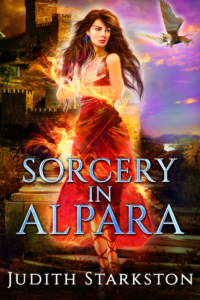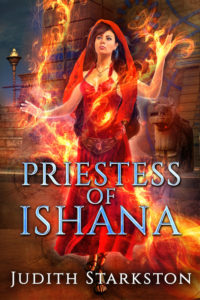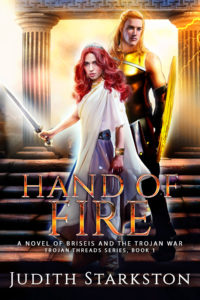An interview with Judith Starkston
 Please join me in welcoming Judith Starkston. In advance of the launch of her second book in her award-winning historical fantasy Tesha series, the first book, Priestess of Ishana, is available for FREE Oct 2-6 on Amazon. This seemed like the perfect time to ask her about her intriguing Tesha series. The second book, Sorcery in Alpara, will launch on Oct 14 (available on preorder).
Please join me in welcoming Judith Starkston. In advance of the launch of her second book in her award-winning historical fantasy Tesha series, the first book, Priestess of Ishana, is available for FREE Oct 2-6 on Amazon. This seemed like the perfect time to ask her about her intriguing Tesha series. The second book, Sorcery in Alpara, will launch on Oct 14 (available on preorder).
You based your fictional main character Tesha on a real Hittite woman, Queen Puduhepa. She is not exactly a household name. How did that source of inspiration come about?
Puduhepa had the misfortune to rule a kingdom that got literally buried and forgotten amidst the upheavals at the end of the Bronze Age (c. 1200 BCE). Hence, even though she ruled for decades over the most powerful empire of the world at the time, she’s barely made it into the history books and only very recently. I discovered Puduhepa originally when researching my first novel set in the Trojan War (Hand of Fire). The culture of Troy was largely that of the Hittites. Fortunately, recent archaeology and the decipherment and translation of many thousands of clay tablets have filled in parts of the lost history. As I researched, I came across the letters, rites and judicial decrees of a highly influential queen who ruled for decades. While doing research, it is enthralling to hear a historical voice coming from across the centuries. Counter to my expectation based on the surrounding kingdoms of the time like Egypt or Babylonia, Hittite queens had full political power by law and custom and remained rulers even when their husbands died. A powerful queen in the extremely patriarchal ancient Near East? I was hooked. Puduhepa caught my imagination with her combination of pragmatic leadership and mystical religious beliefs. I chose her name in my fiction, Tesha, after the Hittite word for ‘dream’ because Puduhepa was famous for visionary dreams sent by her goddess. The other thing she was known for in her lifetime was an astonishingly happy marriage and the equal partnership she maintained with her husband. That also was not the norm in her world.
Given this historical focus, why did you choose to write in the fantasy genre?
For two reasons—one having to do with full disclosure to the reader and the other having to do with Hittite beliefs and their potential for engaging storytelling.
While knowledge about the Hittites has expanded greatly in the last thirty or so years, there still remain giant gaps in historians’ understanding of this intriguing ancient world power. To be honest about my imaginative filling of those gaps, I’m up front that my storytelling combines fantasy and history. For instance, I give my historical figures fictional names, though often only minimally different from their real names.
The other reason I turned to fantasy arose from the prevalence of magic and the supernatural within Hittite religious rites. In essence, I allow those rites to do what the Hittites believed could happen. My main character started her career as a priestess, and her closeness to her goddess was profoundly important to her. Giving her magical beliefs free room also made for much better storytelling. I do extend the fantasy beyond the historical framework when it makes sense for the story, but I start the fantastical elements within Hittite practices, such their extensive use of analogic magic and their obsession with demonic curses. I take the foundational “rules” for my fantasy from Hittite rites themselves, but I find letting my plots go into the fantastical entirely liberating and my readers love it.
My “quarter turn to the fantastic,” to borrow Guy Gavriel Kay’s phrase, allows me to honor what we actually know while also owning up to my inventive extensions.
 Talk about this happy marriage and partnership Puduhepa had. How did that come about?
Talk about this happy marriage and partnership Puduhepa had. How did that come about?
The goddess of love and war, Ishtar, took full credit for this union. (She’s called Ishana in my novels.) A match literally made in heaven, so to speak. Both Puduhepa and Hattusili, her eventual husband, said Ishtar, via dreams, commanded them to marry. They appear to me from the record to be entirely sincere in this understanding. Hattusili was the younger brother of what the Hittites called the “Great King,” the ruler of the Hittite Empire. Hattusili vowed before leading his brother’s troops into battle against Egypt that he would give all his spoils of war to Ishtar if she gave him victory. He viewed Ishtar as his personal patron goddess. He attributed to her his survival of a childhood illness and the rescue from a couple career-ending situations. When he arrived at the finest temple in the realm to make good on his vow, loaded with Pharaoh’s golden treasures, who was there but Priestess Puduhepa, young, very beautiful and incredibly smart? That’s how they met. We have this story from a document Hattusili composed that’s often called his “autobiography” although it isn’t anything like a modern autobiography. In it he also says, “the goddess gave us the love of husband and wife . . . and our household thrived.” We also have Puduhepa’s incredibly poignant prayers on behalf of her husband when he was struck down by ill health. Their equality as partners shows up repeatedly over many years, most visibly in Puduhepa’s independent seal on key treaties and letters where she grants lands to vassal kings and other powerful acts. She shows no signs of needing her husband to “co-sign.” I portray from the inside their early meeting and falling in love, but intriguingly, Hattusili also mentions he was accused of sorcery at this time, an accusation that carried the penalty of death in a legal system that otherwise opted for exile. Interesting that! So I took this divinely inspired love story and combined it with some Bronze Age political intrigue, international scheming, magic and a murder mystery.
Describe one of the strangest details about the Hittites you found from your research.
The Hittites were obsessed with curses of all sorts—what we might call dark magic. They believed sorcerers could sicken and kill their enemies, for example. We find this expressed in places as diverse as court cases and public prayers. One extended rite describes a precise method of removing such a curse. Not all of the text survives in a readable way but my favorite part (which I used in Priestess) describes touching the cursed person with a loaf of specially made bread to absorb the curse’s pollution. The bread is stuffed with chickpea paste (hummus, in essence) as the absorbing substance. Once the bread touches all the prescribed places on the victim’s body, the priestess is commanded to burn it and thus send it back to the demons of the Underworld whence curses were thought to come. I hope I haven’t ruined hummus for any of those reading this interview. It’s one of my favorite foods. I actually wrote a cookbook of Bronze Age foods that people receive (after a short story) when they sign up for my author newsletter, and I have recipes for three different styles of hummus in it, so I’m pretty dedicated to good chickpea paste!
 What’s an aspect of the historical evidence about Puduhepa’s life that you hope readers will absorb from your portrayal of Tesha?
What’s an aspect of the historical evidence about Puduhepa’s life that you hope readers will absorb from your portrayal of Tesha?
Puduhepa provides a worthy model for leadership—particularly the value of female leaders, which we’ve been thinking about lately, so this seems timely. She certainly wasn’t perfect, and some of her actions are hotly debated among historians as possibly self-serving or politically motivated rather than ethically driven. She gave me nuanced material to work into my hero’s character. But, despite that human complexity, or perhaps because of it, she had brilliant skills as queen in many areas: diplomatic, judicial, religious and familial. Most famously, she corralled Pharaoh Ramses II of Egypt into a lasting peace treaty. The surviving letters to Ramses reveal a subtle diplomat with a tough but gracious core that made her able to stand up to the arrogant Pharaoh without giving offense. She also took judicial positions that went against her own citizens when the truth wasn’t on their side. Fair justice wasn’t something she was willing to toss overboard when it was politically inconvenient. Her equal partnership with her husband was a much-admired model even in the patriarchal world of the ancient Near East.
You’ve traveled extensively for research purposes. Can you share some highlights of those travels?
When planning which archaeological sites to visit on my second trip to Turkey, I bemoaned to the Turkish archaeologist who guides and translates for me that the site of Puduhepa’s hometown, Lawazantiya, had never been identified. We know the name, its general location, and that it had seven springs from numerous documents found in the court library excavated from the empire’s capital city, but I thought we lacked even a tentative site location. But my archaeologist friend was more up to date than I was.
A new archaeological excavation, with preliminary results published only locally in Turkish, had made a strong case for being Lawazantiya. Sure enough, there are seven springs in the area around this dig and also extensive Bronze Age ruins on the mound, including parts that could correspond to the famous temple of Ishtar we know existed there (where Puduhepa was priestess).
We arranged to go to the site so that I could study the physical setting and ruins. That would have been splendid all on its own, but, even better, the director of the dig spent the entire day with me, explaining and examining the excavation. We also visited each of the seven springs—locations that I found very useful later as I l drafted Priestess of Ishana. Accompanied by the rest of the dig’s excavators, we had a delightful lunch of freshly caught fish at a restaurant beside the largest of the springs. It was easy to imagine my Tesha and Hattu sitting in the shade of the willows in that lovely spot, although I confess when that spring appears in my novel, it’s all conflict and trouble, not quiet picnicking!
What’s your next project?
I’ve now written the first two books in this series based on Puduhepa’s life, Priestess of Ishana and Sorcery in Alpara. I’m laying out and drafting the third book—no title yet. If readers are interested in my book news, special offers, and the history and archaeology of this ancient civilization (and the cookbook I described), they can sign up for the author newsletter on my website.
Buy link Priestess of Ishana: https://amzn.to/2DXpdXt
Buy link Sorcery in Alpara: https://amzn.to/319vuIj
Buy link Hand of Fire: https://amzn.to/2KOb6a0
Judith’s website: https://www.judithstarkston.com
Sign up for her newsletter: https://www.judithstarkston.com/sign-up-for-my-author-newsletter-for-books-news-special-offers-and-freebies/
Facebook: https://www.facebook.com/judy.starkston
Twitter: https://twitter.com/JudithStarkston



